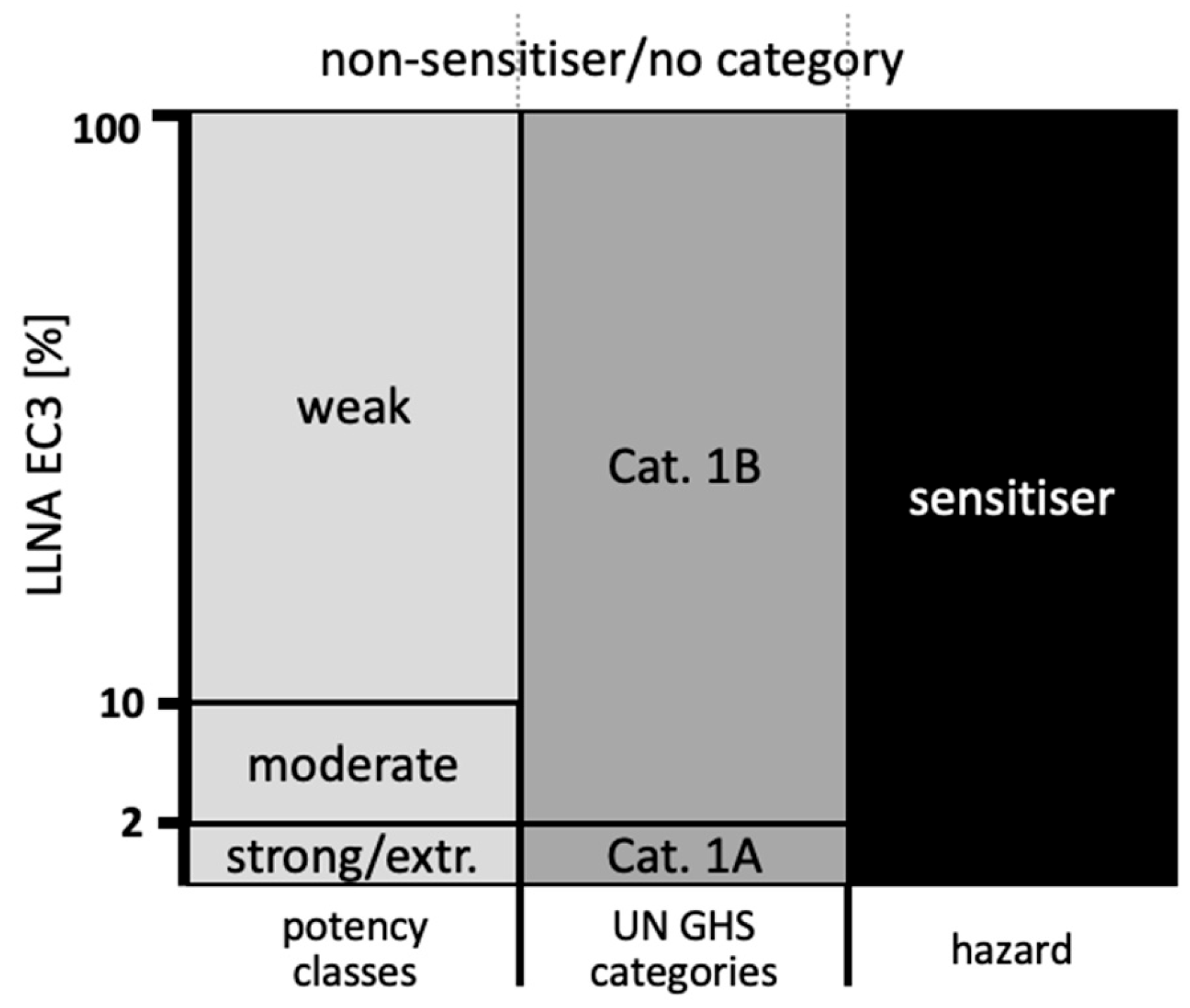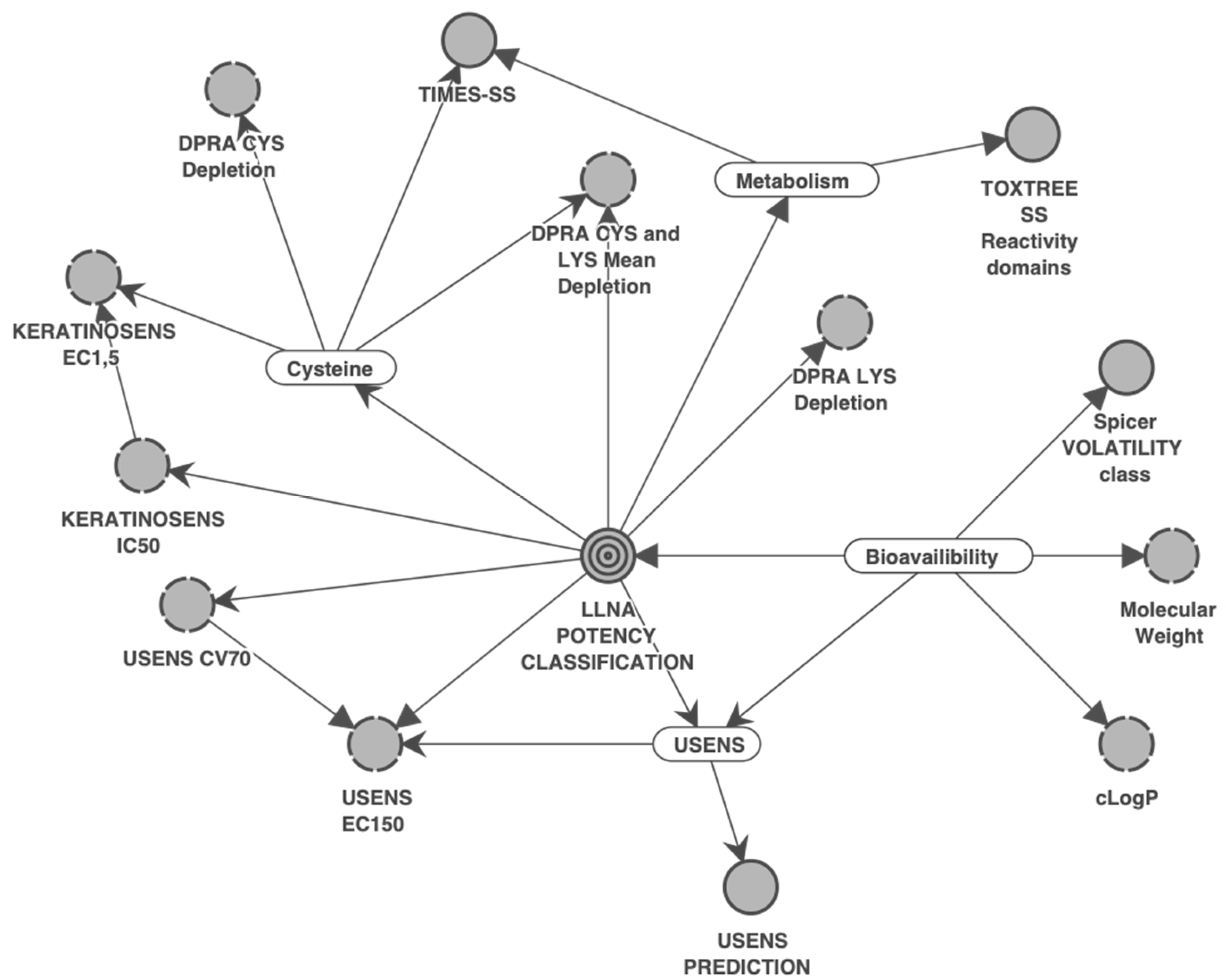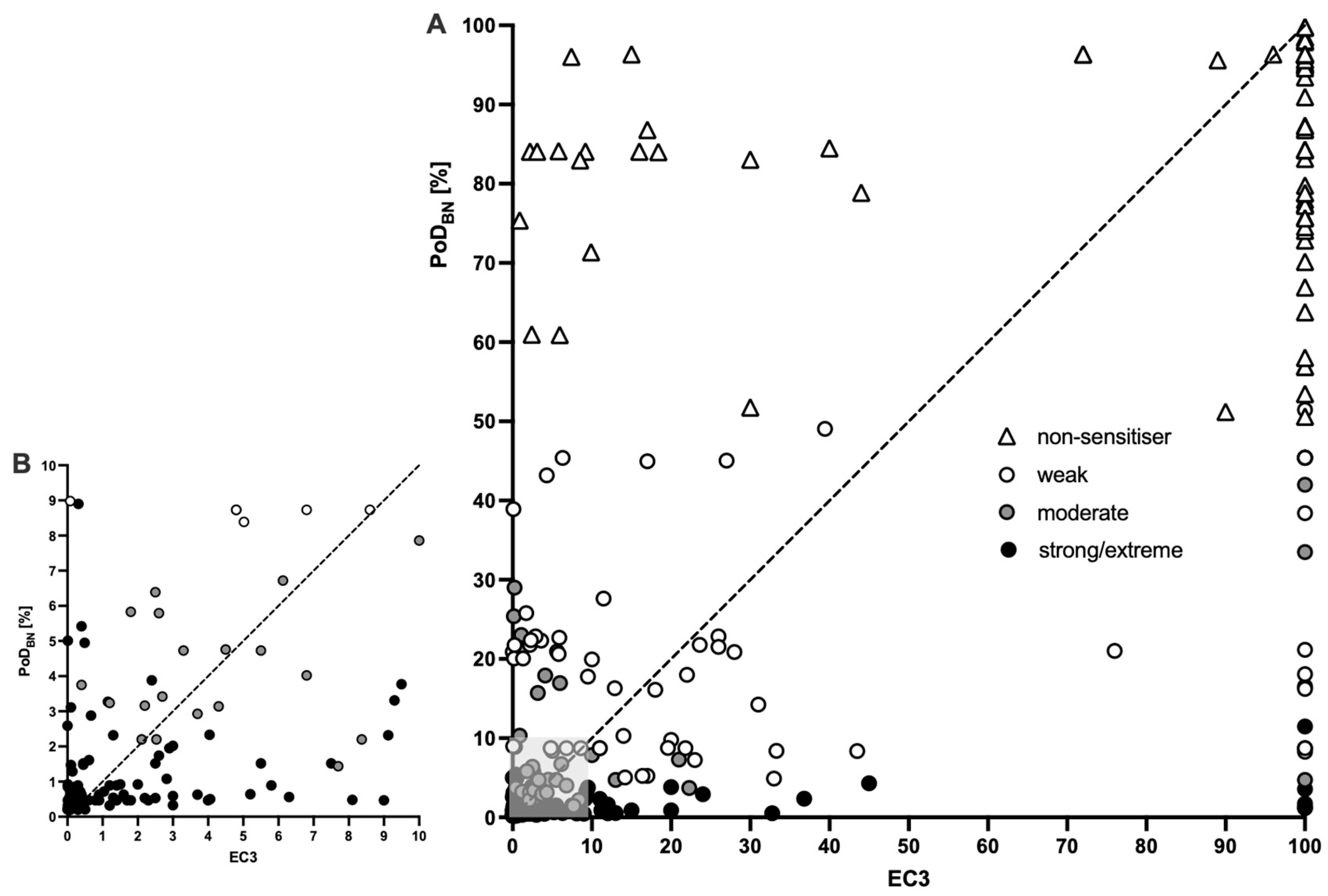Deriving a Continuous Point of Departure for Skin Sensitization Risk Assessment Using a Bayesian Network Model
Abstract
:1. Introduction
2. Materials and Methods
2.1. Data Inputs
2.1.1. NAMs
2.1.2. In Vivo Reference Data
2.2. Bayesian Network
2.2.1. Construction and Training
2.2.2. Performance Analysis
2.3. Confidence Categorization
2.4. PoD Derivation
3. Results
3.1. SkinSens-BN and Its Predictive Performance
3.1.1. The Network Structure
3.1.2. Predictivity: Training and Test Sets, Individual and Combined
3.1.3. Confidence Assessment
3.2. Derivation of a Continuous PoD with SkinSens-BN and Its Comparison to EC3
4. Discussion
Supplementary Materials
Author Contributions
Funding
Institutional Review Board Statement
Informed Consent Statement
Data Availability Statement
Conflicts of Interest
References
- European Commission Regulation (EC) No 1223/2009 of the European parliament and the council of 30 November 2009 on cosmetic products. Off. J. Eur. Union 2009, L342, 59–209.
- SCCS. The SCCS Notes of Guidance for the Testing of Cosmetic Ingredients and Their Safety Evaluation; 12th Revision; SCCS/1647/22; SCCS: Brussels, Belgium, 2023. [Google Scholar]
- Gądarowska, D.; Kalka, J.; Daniel-Wójcik, A.; Mrzyk, I. Alternative Methods for Skin-Sensitization Assessment. Toxics 2022, 10, 740. [Google Scholar] [CrossRef] [PubMed]
- OECD. The Adverse Outcome Pathway for Skin Sensitisation Initiated by Covalent Binding to Proteins; OECD: Paris, France, 2014. [Google Scholar]
- Natsch, A.; Emter, R. Reaction Chemistry to Characterize the Molecular Initiating Event in Skin Sensitization: A Journey to Be Continued. Chem. Res. Toxicol. 2017, 30, 315–331. [Google Scholar] [CrossRef] [PubMed]
- OECD. Test No. 442C: In Chemico Skin Sensitisation; OECD: Paris, France, 2023. [Google Scholar]
- Alépée, N.; Tourneix, F.; Singh, A.; Ade, N.; Grégoire, S. Off to a good start? Review of the predictivity of reactivity methods modelling the molecular initiating event of skin sensitization. ALTEX—Altern. Anim. Exp. 2023, 40, 606–618. [Google Scholar] [CrossRef] [PubMed]
- OECD. Test No. 442D: In Vitro Skin Sensitisation; OECD: Paris, France, 2022. [Google Scholar]
- OECD. Test No. 442E: In Vitro Skin Sensitisation; OECD: Paris, France, 2023. [Google Scholar]
- Jowsey, I.R.; Basketter, D.A.; Westmoreland, C.; Kimber, I. A future approach to measuring relative skin sensitising potency: A proposal. J. Appl. Toxicol. 2006, 26, 341–350. [Google Scholar] [CrossRef] [PubMed]
- Tourneix, F.; Alépée, N.; Detroyer, A.; Eilstein, J.; Ez-Zoubir, M.; Teissier, S.M.; Noçairi, H.; Piroird, C.; Basketter, D.; Del Bufalo, A. Skin sensitisation testing in practice: Applying a stacking meta model to cosmetic ingredients. Toxicol. In Vitro 2020, 66, 104831. [Google Scholar] [CrossRef] [PubMed]
- Tourneix, F.; Alépée, N.; Detroyer, A.; Eilstein, J.; Martinozzi Teissier, S.; Nardelli, L.; Noçairi, H.; Pauloin, T.; Piroird, C.; Del Bufalo, A. Assessment of a defined approach based on a stacking prediction model to identify skin sensitization hazard. Toxicol. In Vitro 2019, 60, 134–143. [Google Scholar] [CrossRef] [PubMed]
- Kleinstreuer, N.C.; Hoffmann, S.; Alepee, N.; Allen, D.; Ashikaga, T.; Casey, W.; Clouet, E.; Cluzel, M.; Desprez, B.; Gellatly, N.; et al. Non-animal sensitization methods to predict skin (II): An assessment of defined approaches. Crit. Rev. Toxicol. 2018, 48, 359–374. [Google Scholar] [CrossRef]
- OECD. Guideline No. 497: Defined Approaches on Skin Sensitisation; OECD: Paris, France, 2023. [Google Scholar] [CrossRef]
- Natsch, A.; Gerberick, G.F. Integrated skin sensitization assessment based on OECD methods (I): Deriving a point of departure for risk assessment. ALTEX—Altern. Anim. Exp. 2022, 39, 636–646. [Google Scholar] [CrossRef] [PubMed]
- Natsch, A.; Gerberick, G.F. Integrated skin sensitization assessment based on OECD methods (II): Hazard and potency by combining kinetic peptide reactivity and the “2 out of 3” Defined Approach. ALTEX—Altern. Anim. Exp. 2022, 39, 647–655. [Google Scholar] [CrossRef]
- Reynolds, J.; Gilmour, N.; Baltazar, M.T.; Reynolds, G.; Windebank, S.; Maxwell, G. Decision making in next generation risk assessment for skin allergy: Using historical clinical experience to benchmark risk. Regul. Toxicol. Pharmacol. 2022, 134, 105219. [Google Scholar] [CrossRef]
- Gilmour, N.; Alépée, N.; Hoffmann, S.; Kern, P.S.; Van Vliet, E.; Bury, D.; Miyazawa, M.; Nishida, H.; Cosmetics, E. Applying a next generation risk assessment framework for skin sensitisation to inconsistent new approach methodology information. ALTEX—Altern. Anim. Exp. 2023, 40, 439–451. [Google Scholar] [CrossRef] [PubMed]
- Gilmour, N.; Kern, P.S.; Alépée, N.; Boislève, F.; Bury, D.; Clouet, E.; Hirota, M.; Hoffmann, S.; Kühnl, J.; Lalko, J.F.; et al. Development of a next generation risk assessment framework for the evaluation of skin sensitisation of cosmetic ingredients. Regul. Toxicol. Pharmacol. 2020, 116, 104721. [Google Scholar] [CrossRef] [PubMed]
- Jaworska, J.S.; Natsch, A.; Ryan, C.; Strickland, J.; Ashikaga, T.; Miyazawa, M. Bayesian integrated testing strategy (ITS) for skin sensitization potency assessment: A decision support system for quantitative weight of evidence and adaptive testing strategy. Arch. Toxicol. 2015, 89, 2355–2383. [Google Scholar] [CrossRef] [PubMed]
- Conrady, S.; Jouffe, L. Bayesian Networks & BayesiaLab—A Practical Introduction for Researchers; Bayesia USA: Nashville, TN, USA, 2015; p. 382. [Google Scholar]
- Gilmour, N.; Reynolds, J.; Przybylak, K.; Aleksic, M.; Aptula, N.; Baltazar, M.T.; Cubberley, R.; Rajagopal, R.; Reynolds, G.; Spriggs, S.; et al. Next generation risk assessment for skin allergy: Decision making using new approach methodologies. Regul. Toxicol. Pharmacol. 2022, 131, 105159. [Google Scholar] [CrossRef] [PubMed]
- Jaworska, J.; Hoffmann, S. Integrated Testing Strategy (ITS)—Opportunities to better use existing data and guide future testing in toxicology. ALTEX—Altern. Anim. Exp. 2010, 27, 231–242. [Google Scholar] [CrossRef] [PubMed]
- Maertens, A.; Golden, E.; Luechtefeld, T.H.; Hoffmann, S.; Tsaioun, K.; Hartung, T. Probabilistic risk assessment—The keystone for the future of toxicology. ALTEX—Altern. Anim. Exp. 2022, 39, 3–29. [Google Scholar] [CrossRef] [PubMed]
- Mentzel, S.; Grung, M.; Tollefsen, K.E.; Stenrød, M.; Petersen, K.; Moe, S.J. Development of a Bayesian network for probabilistic risk assessment of pesticides. Integr. Environ. Assess. Manag. 2022, 18, 1072–1087. [Google Scholar] [CrossRef]
- Strickland, J.; Zang, Q.; Kleinstreuer, N.; Paris, M.; Lehmann, D.M.; Choksi, N.; Matheson, J.; Jacobs, A.; Lowit, A.; Allen, D.; et al. Integrated decision strategies for skin sensitization hazard. J. Appl. Toxicol. 2016, 36, 1150–1162. [Google Scholar] [CrossRef] [PubMed]
- Spicer, C.W.; Gordon, S.M.; Kelly, T.J.; Holdren, M.W.; Mukund, R. Hazardous Air Pollutant Handbook; CRC Press: Boca Raton, FL, USA, 2002. [Google Scholar]
- Patlewicz, G.; Jeliazkova, N.; Safford, R.J.; Worth, A.P.; Aleksiev, B. An evaluation of the implementation of the Cramer classification scheme in the Toxtree software. SAR QSAR Environ. Res. 2008, 19, 495–524. [Google Scholar] [CrossRef] [PubMed]
- Natsch, A.; Emter, R. Nrf2 activation as a key event triggered by skin sensitisers: The development of the stable KeratinoSens reporter gene assay. Altern. Lab. Anim. 2016, 44, 443–451. [Google Scholar] [CrossRef] [PubMed]
- Alépée, N.; Piroird, C.; Nardelli, L. U-SENS™: A U937 Cell Line Activation Test for Skin Sensitization. In Alternatives for Dermal Toxicity Testing; Eskes, C., van Vliet, E., Maibach, H.I., Eds.; Springer International Publishing: Cham, Switzerland, 2017; pp. 311–330. [Google Scholar]
- Piroird, C.; Ovigne, J.M.; Rousset, F.; Martinozzi-Teissier, S.; Gomes, C.; Cotovio, J.; Alepee, N. The Myeloid U937 Skin Sensitization Test (U-SENS) addresses the activation of dendritic cell event in the adverse outcome pathway for skin sensitization. Toxicol. In Vitro 2015, 29, 901–916. [Google Scholar] [CrossRef] [PubMed]
- OECD. Supporting Document to the OECD Guideline 497 on Defined Approaches for Skin Sensitisation; Series on Testing and Assessment; No. 336; OECD: Paris, France, 2021. [Google Scholar]
- Hoffmann, S.; Kleinstreuer, N.; Alepee, N.; Allen, D.; Api, A.M.; Ashikaga, T.; Clouet, E.; Cluzel, M.; Desprez, B.; Gellatly, N.; et al. Non-animal methods to predict skin sensitization (I): The Cosmetics Europe database. Crit. Rev. Toxicol. 2018, 48, 344–358. [Google Scholar] [CrossRef] [PubMed]
- Hoffmann, S. LLNA variability: An essential ingredient for a comprehensive assessment of non-animal skin sensitization test methods and strategies. ALTEX—Altern. Anim. Exp. 2015, 32, 379–383. [Google Scholar] [CrossRef]
- ECETOC. Contact Sensitisation: Classification According to Potency; European Centre for Ecotoxicology and Toxicology of Chemicals: Brussels, Belgium, 2003. [Google Scholar]
- United Nations. Globally Harmonized System of Classification and Labelling of Chemicals (GHS); United Nations: San Francisco, CA, USA, 2015. [Google Scholar]
- Fayyad, U.M.; Irani, K.B. Multi-Interval Discretization of Continuous-Valued Attributes for Classification Learning. In Proceedings of the International Joint Conference on Artificial Intelligence, Chambéry, France, 28 August-3 September 1993. [Google Scholar]
- Good, I.J. Studies in the History of Probability and Statistics. XXXVII A. M. Turing’s statistical work in World War II. Biometrika 1979, 66, 393–396. [Google Scholar] [CrossRef]
- Jeffreys, H. Some Tests of Significance, Treated by the Theory of Probability. Math. Proc. Camb. Philos. Soc. 1935, 31, 203–222. [Google Scholar] [CrossRef]
- Assaf Vandecasteele, H.; Gautier, F.; Tourneix, F.; Vliet, E.V.; Bury, D.; Alépée, N. Next generation risk assessment for skin sensitisation: A case study with propyl paraben. Regul. Toxicol. Pharmacol. 2021, 123, 104936. [Google Scholar] [CrossRef] [PubMed]
- Gautier, F.; Tourneix, F.; Assaf Vandecasteele, H.; van Vliet, E.; Bury, D.; Alépée, N. Read-across can increase confidence in the Next Generation Risk Assessment for skin sensitisation: A case study with resorcinol. Regul. Toxicol. Pharmacol. 2020, 117, 104755. [Google Scholar] [CrossRef] [PubMed]
- OECD. Case Study on the Use of Integrated Approaches for Testing and Assessment for Skin Sensitisation: Demonstrating the Next Generation Risk Assessment Framework Using Geraniol; Series on Testing and Assessent No. 368; OECD: Paris, France, 2022. [Google Scholar]
- OECD. Case Study on the Use of Integrated Approaches for Testing and Assessment for Skin Sensitisation of Diethanolamine: Application of a Next Generation Risk Assessment Framework; Series on Testing and Assessment No. 374; OECD: Paris, France, 2023. [Google Scholar]
- Hirota, M.; Ashikaga, T.; Kouzuki, H. Development of an artificial neural network model for risk assessment of skin sensitization using human cell line activation test, direct peptide reactivity assay, KeratinoSens™ and in silico structure alert parameter. J. Appl. Toxicol. 2018, 38, 514–526. [Google Scholar] [CrossRef] [PubMed]
- Reynolds, G.; Reynolds, J.; Gilmour, N.; Cubberley, R.; Spriggs, S.; Aptula, A.; Przybylak, K.; Windebank, S.; Maxwell, G.; Baltazar, M.T. A hypothetical skin sensitisation next generation risk assessment for coumarin in cosmetic products. Regul. Toxicol. Pharmacol. 2021, 127, 105075. [Google Scholar] [CrossRef] [PubMed]
- Urbisch, D.; Mehling, A.; Guth, K.; Ramirez, T.; Honarvar, N.; Kolle, S.; Landsiedel, R.; Jaworska, J.; Kern, P.S.; Gerberick, F.; et al. Assessing skin sensitization hazard in mice and men using non-animal test methods. Regul. Toxicol. Pharmacol. 2015, 71, 337–351. [Google Scholar] [CrossRef] [PubMed]
- Natsch, A. Integrated skin sensitization assessment based on OECD methods (III): Adding human data to the assessment. ALTEX—Altern. Anim. Exp. 2023, 40, 571–583. [Google Scholar] [CrossRef] [PubMed]
- Natsch, A.; Haupt, T.; Wareing, B.; Landsiedel, R.; Kolle, S.N. Predictivity of the kinetic direct peptide reactivity assay (kDPRA) for sensitizer potency assessment and GHS subclassification. ALTEX—Altern. Anim. Exp. 2020, 37, 652–664. [Google Scholar] [CrossRef]
- Kolle, S.N.; Flach, M.; Kleber, M.; Basketter, D.A.; Wareing, B.; Mehling, A.; Hareng, L.; Watzek, N.; Bade, S.; Funk-Weyer, D.; et al. Plant extracts, polymers and new approach methods: Practical experience with skin sensitization assessment. Regul. Toxicol. Pharmacol. 2023, 138, 105330. [Google Scholar] [CrossRef] [PubMed]
- Ruparel, N.; Islas-Robles, A.; Hilberer, A.; Cantrell, K.; Madrid, M.; Ryan, C.; Gerberick, G.F.; Persaud, R. Deriving a point of departure for assessing the skin sensitization risk of wearable device constituents with in vitro methods. Food Chem. Toxicol. 2024, 189, 114725. [Google Scholar] [CrossRef] [PubMed]
- Strickland, J.; Truax, J.; Corvaro, M.; Settivari, R.; Henriquez, J.; McFadden, J.; Gulledge, T.; Johnson, V.; Gehen, S.; Germolec, D.; et al. Application of Defined Approaches for Skin Sensitization to Agrochemical Products. Front. Toxicol. 2022, 4, 852856. [Google Scholar] [CrossRef] [PubMed]
- Svobodová, L.; Rucki, M.; Vlkova, A.; Kejlova, K.; Jírová, D.; Dvorakova, M.; Kolarova, H.; Kandárová, H.; Pôbiš, P.; Heinonen, T.; et al. Sensitization potential of medical devices detected by in vitro and in vivo methods. ALTEX—Altern. Anim. Exp. 2021, 38, 419–430. [Google Scholar] [CrossRef] [PubMed]





| Training Set | LLNA Reference Data Classes/Categories | ||||||||||||||||
|---|---|---|---|---|---|---|---|---|---|---|---|---|---|---|---|---|---|
| A: 4 potency classes | NS | weak | mod. | strong/extr. | Σ | B: UN GHS categories | no Cat. | Cat. 1B | Cat. 1A | Σ | C: hazard | NS | S | Σ | |||
| SkinSens-BN | NS | 55 | 12 | 7 | 1 | 75 | NS | 55 | 19 | 1 | 75 | NS | 55 | 20 | 75 | ||
| weak (EC3 ≥ 10%) | 7 | 20 | 8 | 6 | 41 | weak/mod. | 11 | 44 | 12 | 67 | S | 14 | 130 | 144 | |||
| mod. (2% ≤ EC3 < 10%) | 4 | 2 | 14 | 6 | 26 | strong/extr. | 3 | 23 | 51 | 77 | Σ | 69 | 150 | 219 | |||
| strong/extr. (EC3 < 2%) | 3 | 5 | 18 | 51 | 77 | Σ | 69 | 86 | 64 | 219 | |||||||
| Σ | 69 | 39 | 47 | 64 | 219 | ||||||||||||
| accuracy | 64% (140/219) | 68% (150/219) | 84% (185/219) | ||||||||||||||
| Test set | |||||||||||||||||
| A: 4 potency classes | NS | weak | mod. | strong/extreme | Σ | B: UN GHS categories | no Cat. | Cat. 1B | Cat. 1A | Σ | C: hazard | NS | S | Σ | |||
| SkinSens-BN | NS | 20 | 1 | 2 | 0 | 23 | NS | 20 | 3 | 0 | 23 | NS | 20 | 3 | 23 | ||
| weak (EC3 ≥ 10%) | 6 | 7 | 6 | 1 | 20 | weak/mod. | 6 | 20 | 4 | 30 | S | 8 | 47 | 55 | |||
| mod. (2% ≤ EC3 < 10%) | 0 | 2 | 5 | 3 | 10 | strong/extr. | 2 | 14 | 9 | 25 | Σ | 28 | 50 | 78 | |||
| strong/extr. (EC3 < 2%) | 2 | 7 | 7 | 9 | 25 | Σ | 28 | 37 | 13 | 78 | |||||||
| Σ | 28 | 17 | 20 | 13 | 78 | ||||||||||||
| accuracy | 53% (41/78) | 63% (49/78) | 86% (67/78) | ||||||||||||||
| Training and test set | |||||||||||||||||
| A: 4 potency classes | NS | weak | mod. | strong/extreme | Σ | B: UN GHS categories | no Cat. | Cat. 1B | Cat. 1A | Σ | C: hazard | NS | S | Σ | |||
| SkinSens-BN | NS | 75 | 13 | 9 | 1 | 98 | NS | 75 | 22 | 1 | 98 | NS | 75 | 23 | 98 | ||
| weak (EC3 ≥ 10%) | 13 | 27 | 14 | 7 | 61 | weak/mod. | 17 | 64 | 16 | 97 | S | 22 | 177 | 199 | |||
| mod. (2% ≤ EC3 < 10%) | 4 | 4 | 19 | 9 | 36 | strong/extr. | 5 | 37 | 60 | 102 | Σ | 97 | 200 | 297 | |||
| strong/extr. (EC3 < 2%) | 5 | 12 | 25 | 60 | 102 | Σ | 97 | 123 | 77 | 297 | |||||||
| Σ | 97 | 56 | 67 | 77 | 297 | ||||||||||||
| accuracy | 61% (181/279) | 67% (199/297) | 85% (252/297) | ||||||||||||||
| Substance Name | Geraniol | N,N-dibutylaniline | Hydroxycitronellal | |||
|---|---|---|---|---|---|---|
| LLNA EC3 (UN GHS cat.) | 26% (1B) | 19.6% (1B) | 33% (1B) | |||
| SkinSens-BN | Prob. Profile | W | Prob. Profile | W | Prob. Profile | W |
| p(NS) | 0.1539 | −4.02 | 0.0247 | −1.26 | 0.0017 | −2.43 |
| p(weak) | 0.7240 | 10.96 | 0.5687 | 7.97 | 0.3912 | 4.84 |
| p(moderate) | 0.1144 | −3.38 | 0.2930 | 1.69 | 0.3810 | 3.41 |
| p(strong/ext.) | 0.0078 | −1.72 | 0.1135 | −5.08 | 0.2261 | −1.45 |
| predicted class | weak | weak | weak | |||
| confidence | high | moderate | low | |||
| Substance Name | Lilial | 4-Methoxy-α-methyl benzenpropanal | 3,4-Dihydro- coumarin | |
|---|---|---|---|---|
| LLNA EC3 | 8.6% | 23.6% | 5.6% | |
| UN GHS category | 1B | 1B | 1B | |
| SkinSens-BN probability profile | p(NS) | 0.0244 | 0.1605 | 0.1614 |
| p(weak) | 0.5685 | 0.5185 | 0.3946 | |
| p(moderate) | 0.2934 | 0.2736 | 0.4284 | |
| p(strong/extreme) | 0.1138 | 0.0474 | 0.0156 | |
| predicted class (PoD as lower bound of predicted class) | Weak (10%) | Weak (10%) | Moderate (2%) | |
| confidence | moderate | moderate | low | |
| PoDBN | 8.73% | 21.79% | 20.94% | |
Disclaimer/Publisher’s Note: The statements, opinions and data contained in all publications are solely those of the individual author(s) and contributor(s) and not of MDPI and/or the editor(s). MDPI and/or the editor(s) disclaim responsibility for any injury to people or property resulting from any ideas, methods, instructions or products referred to in the content. |
© 2024 by the authors. Licensee MDPI, Basel, Switzerland. This article is an open access article distributed under the terms and conditions of the Creative Commons Attribution (CC BY) license (https://creativecommons.org/licenses/by/4.0/).
Share and Cite
Tourneix, F.; Carron, L.; Jouffe, L.; Hoffmann, S.; Alépée, N. Deriving a Continuous Point of Departure for Skin Sensitization Risk Assessment Using a Bayesian Network Model. Toxics 2024, 12, 536. https://doi.org/10.3390/toxics12080536
Tourneix F, Carron L, Jouffe L, Hoffmann S, Alépée N. Deriving a Continuous Point of Departure for Skin Sensitization Risk Assessment Using a Bayesian Network Model. Toxics. 2024; 12(8):536. https://doi.org/10.3390/toxics12080536
Chicago/Turabian StyleTourneix, Fleur, Leopold Carron, Lionel Jouffe, Sebastian Hoffmann, and Nathalie Alépée. 2024. "Deriving a Continuous Point of Departure for Skin Sensitization Risk Assessment Using a Bayesian Network Model" Toxics 12, no. 8: 536. https://doi.org/10.3390/toxics12080536





